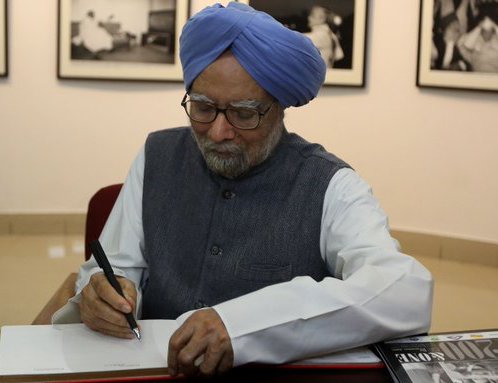
Manmohan Singh did not visit Nepal when he was the Prime Minister of India for a decade. But significant and radical political changes took place next door during his tenure. Nepal, till then the world’s only Hindu Kingdom became a secular republic with India’s backing. Maoists led an armed insurgency for a decade from 1996. In 2006, after a 12-point agreement mediated by India, they and seven other political parties came up as an alliance against King Gyanendra Shah’s direct rule. Maoists coming to the centre stage of power within the democratic framework marked the end of an insurgency that had taken a toll of over 10,000 people. However, Nepal continues to suffer from political instability, and the failure of parties to complete the peace process. Victims of the conflict continue their struggle, and demand the perpetrators of human right violations, including top leaders of the Maoists, be brought to justice.
Dr Singh’s engagements with Nepal were few, but meaningful. During a meeting with King Gyanendra Shah in April 2005 in Jakarta, the latter requested that India resume supply of arms and ammunition to the Nepal army, which India had stopped after King assumed direct rule. In November 2005, at the Dhaka SAARC summit — Shah in the wake of reports that India may support Nepal Maoists — said, “We cannot make a distinction between good and bad terrorism; terrorism is terrorism.” The summit saw Afghanistan’s entry into SAARC as a member although Nepal had slight reservations about a country with foreign forces becoming a part of the regional body. China was also accepted as an observer. India was seemingly not happy with Nepal’s role in both.
In the two weeks that followed, the 12-point agreement was formalized and a mass movement for restoration of democracy began in April, as scripted. Ranjit Rae who was involved in formalizing the deal and later served as Ambassador to Nepal, hints in his book Kathmandu Dilemma: Resetting India-Nepal that the then Army Chief J J Singh had reservations about India supporting the Maoists.
Karan Singh visited Nepal as a special emissary of the PM in April 2006, in company of the then foreign secretary Shyam Saran. King Gyanendra agreed to hand over power to agitating political parties and appointed G P Koirala as the prime minister. This was welcomed by OM Singh, then in Berlin, saying that “India stood by two principles”, implying continuation of constitutional monarchy and multi-party democracy in Nepal.
In fact, in the rarest of such acts, a serving foreign secretary publicly contradicted the PM’s official line – and won. Saran says in his book, How India Sees The World: From Kautilya to the 21st Century, that he obtained the permission of Pranab Mukherjee, then officiating as PM to hold a televised press conference “that what I was saying would be at variance with a statement the prime minister had made the same day in Berlin to the Indian journalists accompanying him.”
Prime Minister Singh, however, fulfilled a ceremonial role when he received Koirala at the Indira Gandhi International Airport personally in June 2006, and called him a “legendary statesman of South Asia”. It was also perhaps a correction to the statement he made in Berlin in April.
But how comfortable he was with Nepal’s radical and Maoist leaders is little known.
Bhutan’s king personally attended Dr Singh’s funeral in Delhi, but there was no one from Nepal representing the government or the state. Top dignitaries from Nepal even on official visits to India have stopped the practice of meeting or engaging with any Opposition leaders, including former prime ministers. The past four years have seen leaders visiting the ruling party office.
In fact, senior Nepali politicians who benefitted from India’s role in the change in 2006, feel more comfortable meeting bureaucrats who played crucial roles then, and not the political bosses of the time.
India is criticized by many for things going wrong after the radical change, especially after it discouraged people’s involvement through referendums on crucial issues — “monarchy vs. republic”, “unitary vs. federal” or continuing with a Hindu Nepal or adopting secularism.
Former US President Jimmy Carter, another statesman, had taken a lot of interest in Nepal placing emphasis on human rights and “freedom of religion”. In April 2008, President Carter in his capacity as the key international observer certified Nepal’s election to the first constituent assembly as reasonably free and fair when the polling was still on, something that showed he was putting trust in Maoists, his future allies. Maoists were an important tool in the promotion of “religious freedom” maintaining silence on proselytisation, an issue fiercely debated still.
Manmohan Singh’s India did face a new challenge in Nepal with China entering the southern border after India, EU and the US began working together as stakeholders in peace-building and consolidating democracy. Dr Singh personally maintained a dignified distance and silence from Nepal’s internal affairs.
The writer is the Kathmandu-based contributing editor of The Indian Express
Reproduced from The Indian Express

Yubaraj Ghimire
Ghimire is a Kathmandu based journalist.
- Why ‘Revolutionary’ Communist PM Prachanda Went To Temples In India
- Jun 08, 2023
- Why China Is Happy With Nepal’s New PM
- Jan 03, 2023
- Prachanda Sworn In As PM: New Tie-ups In Nepal, Concern In India
- Dec 27, 2022
- Young TV Anchor As Its Face, RSP Rise Takes Nepal By Surprise
- Nov 23, 2022
- Nepal Votes, Why The Verdict May Not Make New Delhi Very Happy
- Nov 23, 2022














